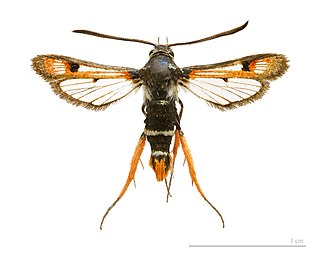Related Research Articles

Sesioidea is the superfamily currently containing clearwing moths (Sesiidae), castniid moths (Castniidae) and little bear moths (Brachodidae). There is evidence from head and thoracic morphology that the first two families, internally feeding in plants as caterpillars, are sisters, whilst some brachodids are known to feed on leaf surfaces. Sesioidea are considered to be the sister group of Cossoidea which contain the also internal-feeding Goat and Leopard moths.

Castniidae, or castniid moths, is a small family of moths with fewer than 200 species: The majority are Neotropical with some in Australia and a few in south-east Asia. These are medium-sized to very large moths, usually with drab, cryptically-marked forewings and brightly coloured hindwings. They have clubbed antennae and are day flying, and are often mistaken for butterflies. Indeed, some previous classification systems placed this family within the butterflies or skippers. The Neotropical species are commonly known as giant butterfly-moths, the Australian and Asian species as sun moths. The larvae are internal feeders, often on roots of epiphytes or on monocotyledons.

Telchin licus, the banana stem borer, is a moth of the Castniidae family. It is native to South America, where it is found from Colombia, Venezuela and the Guianas, throughout the Amazon basin in Brazil and Peru. It has also been recorded as an introduced species in Hawaii.
Synpalamides escalantei is a moth of the Castniidae family. It was described by Miller in 1976, and is known from Mexico.

Spilopastes is a genus of moths within the Castniidae family, containing one species, Spilopastes galinthias which is known from Brazil.

Castniomera is a monotypic moth genus in the family Castniidae described by Constant Vincent Houlbert in 1918. Its single species, Castniomera atymnius, the giant butterfly-moth, was first described by Johan Wilhelm Dalman in 1824. It is known from Mexico through Central America to Venezuela.

Zegara zagraea is a moth of the Castniidae family. It is found in Central America and northern South America.

Xanthocastnia is a genus of moths within the family Castniidae containing only one species, Xanthocastnia evalthe, which is widespread in the Neotropical realm, ranging from southern Mexico to southern Brazil.
Riechia is a genus of moths within the family Castniidae containing only one species, Riechia acraeoides, which is found in Peru, Paraguay, Brazil and Argentina.
Insigniocastnia is a genus of moths within the family Castniidae containing only one species, Insigniocastnia taisae, which is found in Ecuador.

Amauta papilionaris is a moth in the Castniidae family. It is found in Colombia, Venezuela, Peru, Bolivia, Ecuador and Panama.
Castnia invaria is a moth in the family Castniidae. It is found in South America.
Athis palatinus is a moth in the Castniidae family. It is found from Mexico south to Peru and Brazil.
Athis therapon is a moth in the family Castniidae. It is found in Brazil. It was once introduced to New Jersey.
Dominickus is an extinct genus of moth in the butterfly-moth family Castniidae containing a single species Dominickus castnioides. The species is known from late Eocene, Priabonian stage, lake deposits near the small community of Guffey in Teller County, Colorado, United States.
Zegara personata is a moth in the Castniidae family. It is found in Colombia and Ecuador.
Mirocastnia pyrrhopygoides is a moth in the Castniidae family. It is found in Ecuador, Peru and Colombia.
Mirocastnia canis is a moth in the Castniidae family. It is found in Peru.
Haemonides cronis is a moth in the Castniidae family. It is found in Mexico, Trinidad, Suriname, French Guiana, Brazil and Peru.
Lapaeumides zerynthia is a moth in the Castniidae family. It is found in Brazil, in the Neotropical realm. This species is likely found in lowland tropical forests, but future research is needed to confirm this.
References
- ↑ Oiticicastnia at funet.fi.
- ↑ Hétérocères de Guyane Française - Castniidae Archived May 22, 2010, at the Wayback Machine
| This article relating to moth family Castniidae is a stub. You can help Wikipedia by expanding it. |